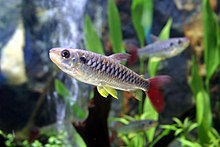Chalceidae
| Chalceidae | |
|---|---|

| |
| Chalceus macrolepidotus | |
| Scientific classification | |
| Kingdom: | |
| Phylum: | |
| Class: | |
| Order: | |
| Family: | Chalceidae Fowler, 1958
|
Chalceidae, the tucanfishes[1][2], is a family of freshwater fish first described by Henry Weed Fowler in the year 1958. It is a monotypic family, home only to the genus incertae sedis Chalceus.
All members of the family inhabit areas of northern South America, including the Amazon River and various tributaries[3].
Classification
Chalceidae is in the order Characiformes. The genus Chalceus used to be placed in the family Characidae, and is still listed there by several sources (like GBIF and ITIS)[4]. Research since its original placement suggested movement into the family Chalceidae, based upon phylogenetic significance as a monophyletic group[5]. Morphological features further support this move[6]. This was also done in order to keep the family Characidae monophyletic[5].
Currently, only Chalceus is classified in Chalceidae. Because Chalceus is a genus with five extant species, Chalceidae has five extant species by extension[7][8]. In alphabetical order, they are:
- Chalceus epakros Zanata & Toledo-Piza, 2004
- Chalceus erythrurus Cope, 1870 (tucan fish)
- Chalceus guaporensis Zanata & Toledo-Piza, 2004
- Chalceus macrolepidotus Cuvier, 1818 (pinktail chalceus)
- Chalceus spilogyros Zanata & Toledo-Piza, 2004
History

Chalceidae was first described in 1958 by Henry Weed Fowler as Chalceidi[9]. It has also been described as Plethodectidi by the same[10]; this is because Plethodectes erythrurus (Cope, 1870) used to be the sole representative, a name now synonymized with Chalceus erythrurus[11][12]. Therefore, the family Plethodectidi became defunct alongside the genus Plethodectes (in the context of describing species of Chalceus).
Etymology
The sole genus of Chalceidae, Chalceus, gives the family its name and therefore its etymological root. Said root is the Greek word chalkos, which means copper[13][14]; this is in reference to the original description of C. macrolepidotus, wherein Georges Cuvier reported that its scales were "sometimes golden" when preserved in alcohol[2][15].
References
- ^ Froese, Rainer, and Daniel Pauly, eds. (2021). "Chalceidae" in FishBase. December 2021 version.
- ^ a b Scharpf, Christopher; Lazara, Kenneth J. (15 September 2020). "Order CHARACIFORMES: Families IGUANODECTIDAE, TRIPORTHEIDAE, BRYCONIDAE, CHALCEIDAE and GASTEROPELECIDAE". The ETYFish Project. Retrieved 26 December 2021.
- ^ "COPEPEDIA summary for Chalceidae : T5006059 : Family". www.st.nmfs.noaa.gov. Retrieved 2021-12-26.
- ^ "Chalceus names - Encyclopedia of Life". eol.org. Retrieved 2021-12-26.
- ^ a b Oliveira, C., Avelino, G.S., Abe, K.T., Mariguela, T.C., Benine, R.C., Orti, G., Vari, R.P., & Correa e Castro, R.M. (2011): Phylogenetic relationships within the speciose family Characidae (Teleostei: Ostariophysi: Characiformes) based on multilocus analysis and extensive ingroup sampling. BMC Evolutionary Biology, 11: 275. doi: 10.1186/1471-2148-11-275
- ^ Cástor Guisande, Patricia Pelayo-Villamil, Manuel Vera, Ana Manjarrés-Hernández, Mónica R. Carvalho, Richard P. Vari, Luz Fernanda Jiménez, Carlos Fernández, Paulino Martínez, Edgar Prieto-Piraquive, Carlos Granado-Lorencio, Santiago R. Duque, "Ecological Factors and Diversification among Neotropical Characiforms", International Journal of Ecology, vol. 2012, Article ID 610419, 20 pages, 2012. https://doi.org/10.1155/2012/610419
- ^ "Taxonomic revision of the South American fish genus Chalceus Cuvier (Teleostei: Ostariophysi: Characiformes) with the description of three new species". Zoological Journal of the Linnean Society. 140 (11): 103–135. 2004. doi:10.1111/j.1096-3642.2004.00090.x.
{{cite journal}}: Cite uses deprecated parameter|authors=(help) - ^ Fricke, Ron; Eschmeyer, William N.; Fong, Jon D. (2020). "Genera/Species of Fishes by Family/Subfamily". Eschmeyer's Catalog of Fishes. California Academy of Sciences. Retrieved 26 December 2021.
- ^ Fowler, Henry Weed (1958). "Some new taxonomic names of fishlike vertebrates". Notulae Naturae. 310. Retrieved 26 December 2021.
- ^ Van der Laan, R., Eschmeyer, W.N., & Fricke, R. (2014). Family-group names of Recent fishes. Zootaxa, 3882, 1-230.
- ^ Cope, Edward Drinker (1870). "Contribution to the Ichthyology of the Maranon". Proceedings of the American Philosophical Society. 11 (81): 563–564. Retrieved 26 December 2021.
- ^ Cope, Edward Drinker (1872). "On the fishes of the Ambyiacu River". Proceedings of the Academy of Natural Sciences of Philadelphia. 23: 262. Retrieved 26 December 2021.
- ^ "Glosbe". Copper in Ancient Greek (to 1453). Retrieved 26 December 2021.
- ^ Hackh, Ingo W. D. (1918). "The Romance of the Chemical Elements". American Journal of Pharmacy and the Sciences Supporting Public Health. 90: 490. Retrieved 26 December 2021.
- ^ Cuvier, Georges (1818). "Sur les Poissons du sous-genre Myletes". Mémoires du Muséum d'histoire naturelle. 4: 454. Retrieved 24 December 2021.
